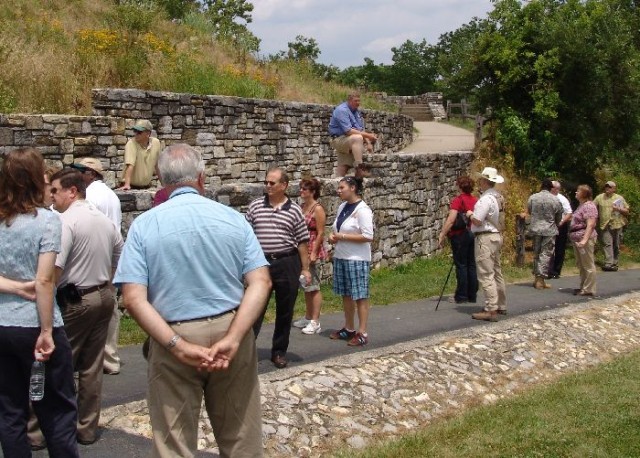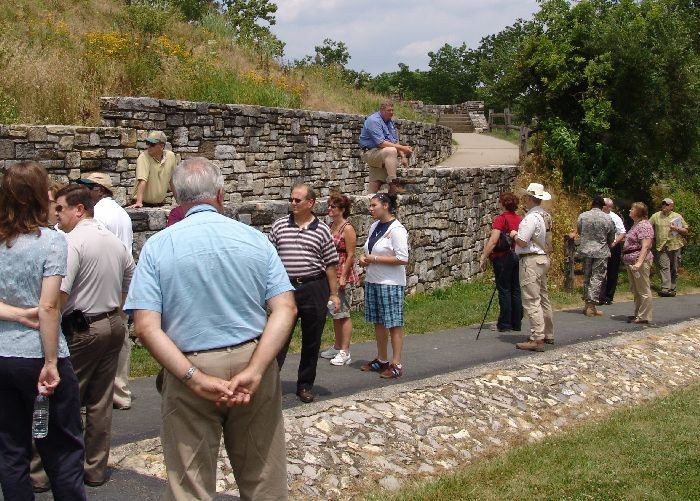by Chuck Gordon
If you know anything about the Battle of Antietam, you probably remember that it was the single bloodiest day of the Civil War, and one of the bloodiest battles in American history.
What you might not know is that events prior to, during and immediately following Antietam laid the foundation for the modern Army (and, indeed, civilian emergency care) system.
"In the early days of the Civil War, medicine on the battlefield was pretty haphazard," said George Wunderlich, executive director of the National Museum of Civil War Medicine in Frederick. "but events leading up to the Battle at Antietam, and specifically, the work of one man changed everything."
Wunderlich recently conducted a staff ride at Antietam and the nearby Pry House Field Hospital Museum for the staff of U.S. Army Garrison Fort Detrick. It was the second outing at the battlefield that lies about 24 miles west of the fort on old Route 40.
"What I want to show you today," he said, "is how the actions of that one man created the framework for modern military medicine, and how what he did very probably affected the way you do your jobs at Fort Detrick,"
The man was Maj. Jonathon Letterman, the medical director of the Army of the Potomac under Union army commander Maj. Gen. George B. McClellan.
Letterman had been an Army surgeon since 1849, and had treated wounded Soldiers in Florida and New Mexico in campaigns against the Seminole and Apache tribes and in California aginst the Utes.
The Union Army had recently taken serious casualties during the Seven Days Battle, in June 1862, near Richmond, Va., and the medical system in place had proven unable to effectively deal with the number of wounded.
McLellan's mandate to Letterman was clear: Do whatever was necessary to improve the system.
"Within weeks of receiving his appointment, Letterman devised a plan," said Wunderlich, "and that plan was tested under fire right here. He basically walked into the Battle of South Mountain, and a few weeks later was in battle again here at Antietam."
Gesturing toward Route 40, Wunderlich conjured images of a one-lane road, crowded with troops, wagons, horses and artillery.
"Back in Frederick, Letterman took over churches, public halls, anywhere spacious enough, and set up hospitals," Wunderlich said. "And Route 40 was the road between the hospitals and the battlefield."
Casualties in ambulances had to swim upstream against the flood of men and materiel rolling toward the battle.
Antietam was the first major battle of the war to occur on Union Soil, and between 5:30 a.m. and 5:30 p.m., some 23,000 Americans on both sides of the conflict had been wounded or killed.
"And that's the 23,000 we know about," said Wunderlich. "That figure doesn't include non-combat-related injuries and illness. Remember that these Soldiers were already sick, tired and were eating rotten food and drinking filthy water."
The figure also cannot account for some Soldiers who, caught in artillery fire, simply disintegrated.
"The prevailing attitude toward military surgeons at the time was pretty much, 'You're a doctor, go doctor and stay out of the way,'" said Wunderlich. "But that was unacceptable to letterman, and his plan literally changed the way the Army treated casualties, and laid the foundations for modern Army medicine."
In a nutshell, Letterman's plan was the genesis of the three-tiered evacuation system which is still used today: field dressing/aid stations near the battlefield, field hospitals further away in barns or homes,and large hospitals away from the battlefield.
"In addition to the organization of aid stations and hospitals," Wunderlich said, "Letterman pretty much built an ambulance corps from the ground up."
Previously, wounded would be carried off the filed by buddies, limp to field hospital on their own, or lie on the field until the battle was over and stretcher bearers arrived.
"He appropriated ambulances, trained corpsmen, and supplied them with everything they needed to collect the wounded, get them to an aid station and then to a larger hospital," said Wunderlich. "and he organized an efficient system of distributing medical supplies.
The Letterman Plan was tested again at the battle of Fredericksburg, Va., where the Army of the Potomac suffered more than 12,000 casualties. After Fredericksburg, Letterman's system was adopted by the other Union Armies, and was adopted as the U.S. Army medical system by act of Congress in 1864.
The structure of the Letterman Plan is the foundation of the way the Army treats, transports and protects the wounded today and is at the core of modern defense medical logistics.
"The system worked. Spectacularly," said Wunderlich. "And as result, the Letterman plan touches the mission each of you do today at Fort Detrick."
Letterman was a visionary who didn't come up with his ideas out of the blue, but rather borrowed existing ideas and synthesized them into a cohesive whole.
"He took a piece from the British Army in the Crimean War, a piece from the French Army, he took whatever he instinctively understood to be best practices," said Wunderlich. "Letterman opened a new era of medical command and control, hospital administration, and protocols for triage, systematic first aid and an ambulance system. He was a visionary, and an inspired leader."




Social Sharing